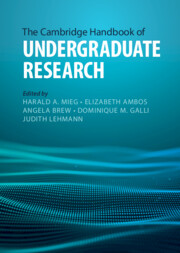Book contents
- The Cambridge Handbook of Undergraduate Research
- The Cambridge Handbook of Undergraduate Research
- Copyright page
- Contents
- Figures
- Tables
- Contributors
- Foreword
- Foreword
- 1 Introduction
- Part I Theory and Research on Undergraduate Research
- Part II Implementation, Approaches, Methods
- Part III Disciplines
- Part IV International Perspective
- Part V Avenues for Developing Undergraduate Research
- 73 Synopsis and Introduction
- 74 Community-Based Undergraduate Research
- 75 Interdisciplinary Undergraduate Research
- 76 Undergraduate Research in Digital Learning Environments
- 77 Crosscultural Undergraduate Research
- Index
- References
75 - Interdisciplinary Undergraduate Research
from Part V - Avenues for Developing Undergraduate Research
Published online by Cambridge University Press: 11 August 2022
- The Cambridge Handbook of Undergraduate Research
- The Cambridge Handbook of Undergraduate Research
- Copyright page
- Contents
- Figures
- Tables
- Contributors
- Foreword
- Foreword
- 1 Introduction
- Part I Theory and Research on Undergraduate Research
- Part II Implementation, Approaches, Methods
- Part III Disciplines
- Part IV International Perspective
- Part V Avenues for Developing Undergraduate Research
- 73 Synopsis and Introduction
- 74 Community-Based Undergraduate Research
- 75 Interdisciplinary Undergraduate Research
- 76 Undergraduate Research in Digital Learning Environments
- 77 Crosscultural Undergraduate Research
- Index
- References
Summary
With radical changes in social problems and the need for research to be application-oriented a change has been noticed in undergraduate research (UR) as it tends to become interdisciplinary in nature. Interdisciplinary research is developing intensively, drawing from various fields of research as opposed to the traditional form of research. Although the institutionalization of UR is a relatively recent phenomenon within the higher education community, the roots of research-focused universities can be traced back to the nineteenth century with the Humboldtian model of higher education (i.e., the integration of research and teaching) and the founding of the University of Berlin. Interdisciplinary undergraduate research (IUR) takes UR to a higher cognitive level by conducting research with students across the sciences, humanities, and the arts. This chapter focuses on how IUR is being used to increase student engagement and academic achievement. Within this context, this chapter addresses the following two research questions: (1) How is UR fostered or transformed by interdisciplinarity to produce IUR? and (2) What are the future challenges of UR with respect to interdisciplinarity?
Keywords
- Type
- Chapter
- Information
- The Cambridge Handbook of Undergraduate Research , pp. 683 - 694Publisher: Cambridge University PressPrint publication year: 2022

